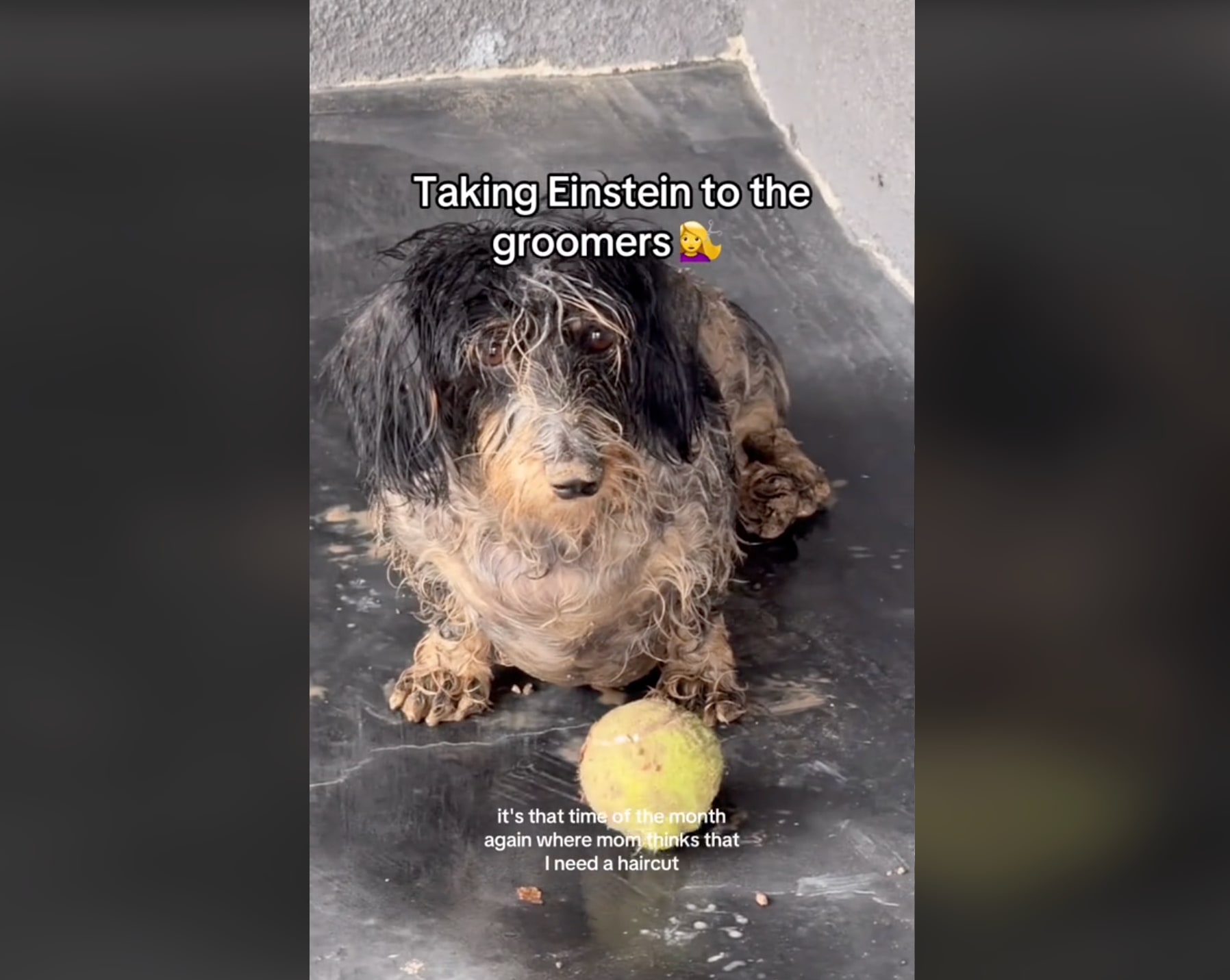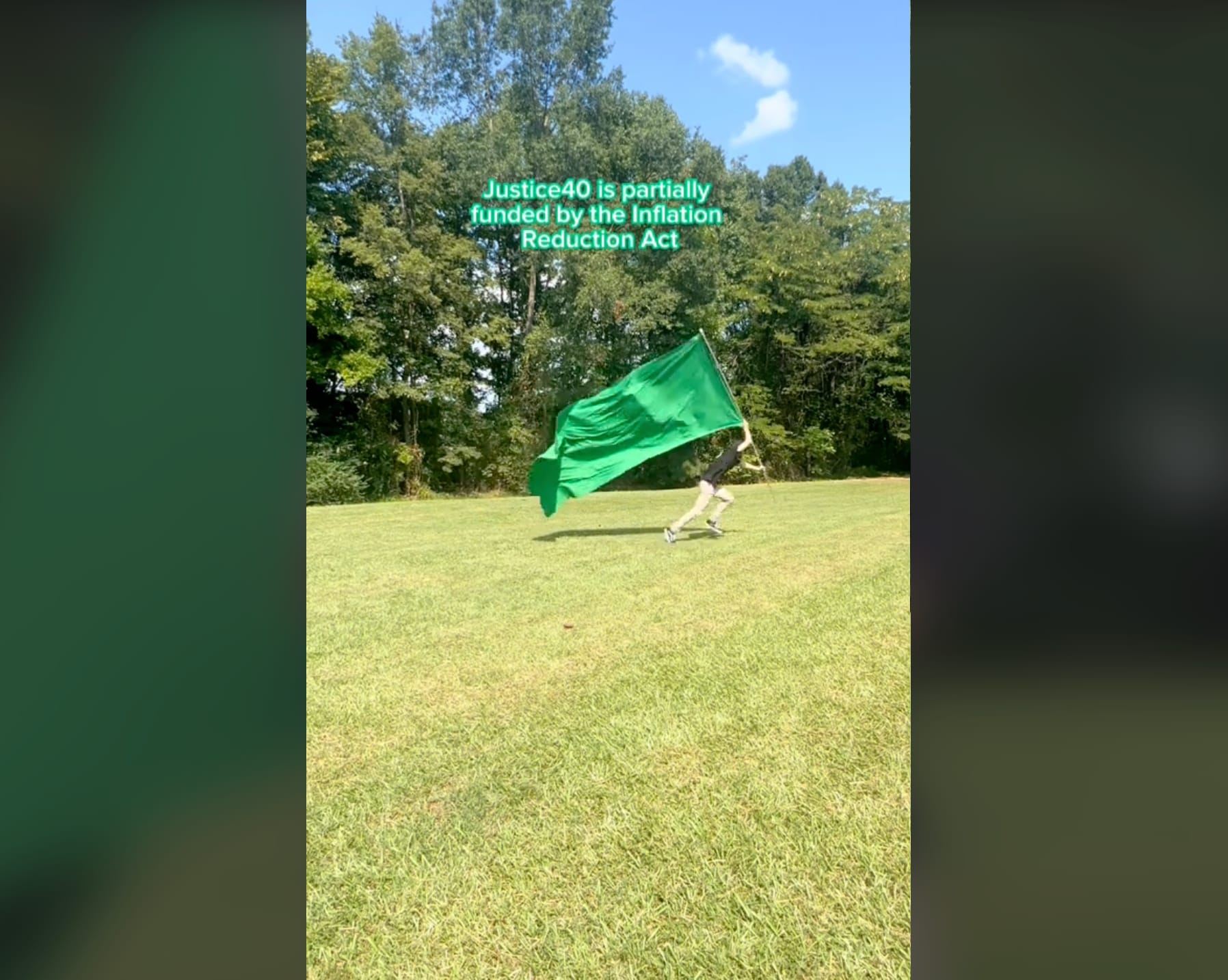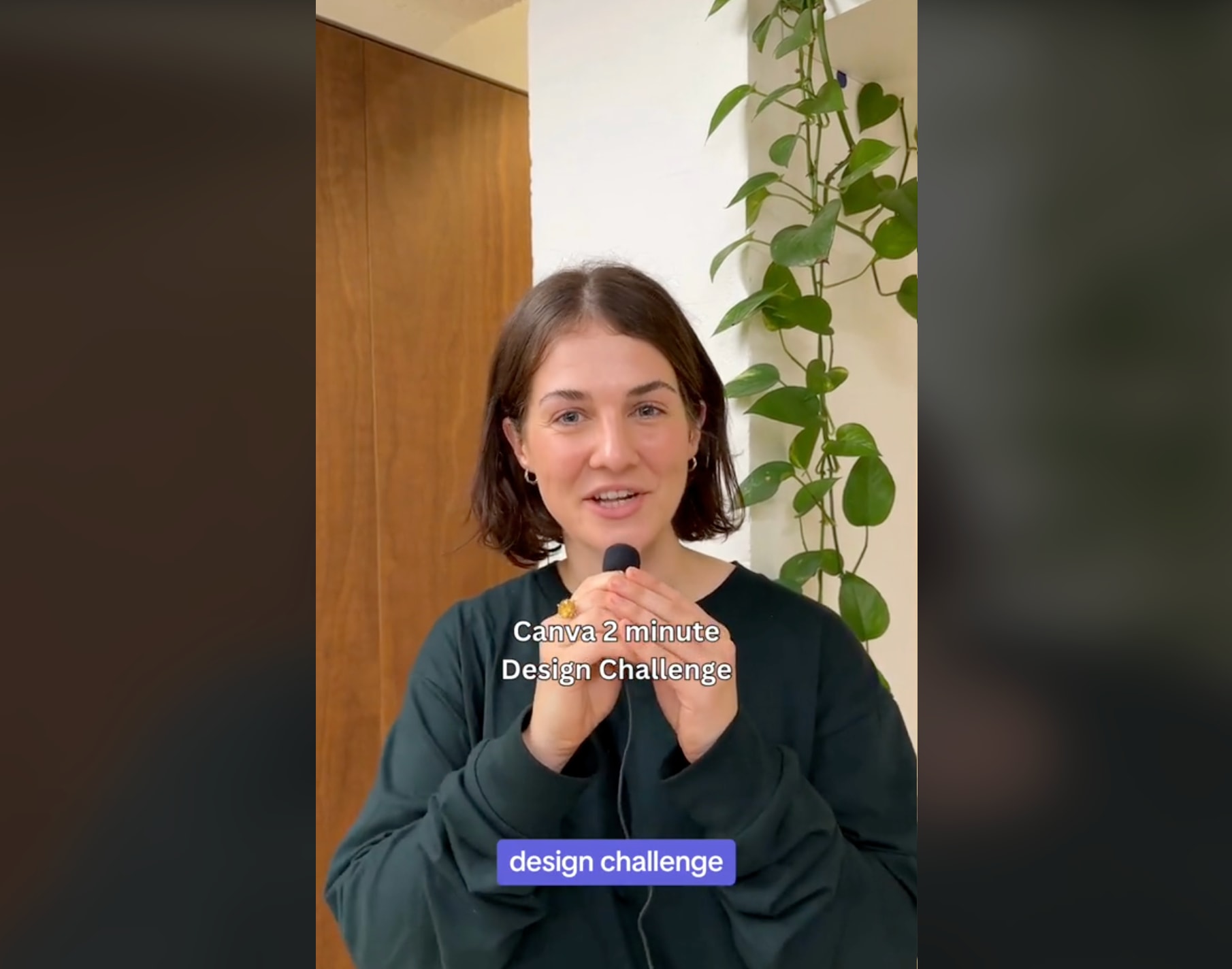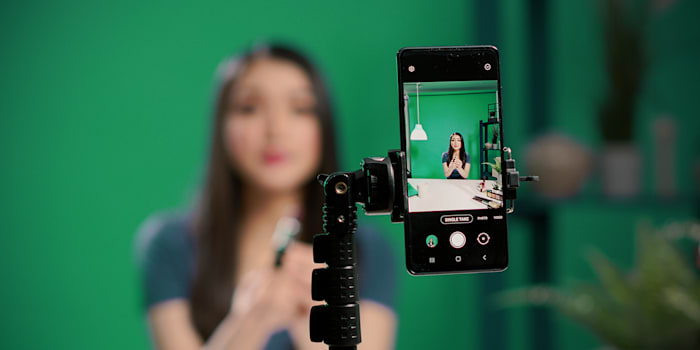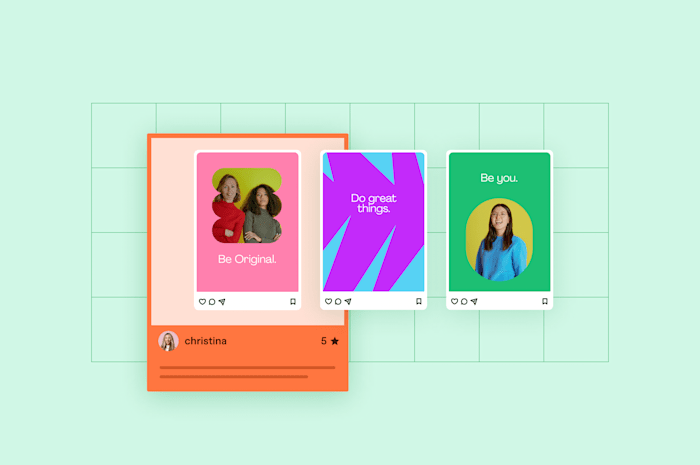11 User-Generated Content (UGC) Strategies to Try (and Succeed)
User-generated content is a useful marketing strategy for your brand. Discover top UGC strategies to make sure you have plenty of high-quality and authentic content to share with your audience.
 November 23, 2024
November 23, 2024 13 minute reading
13 minute reading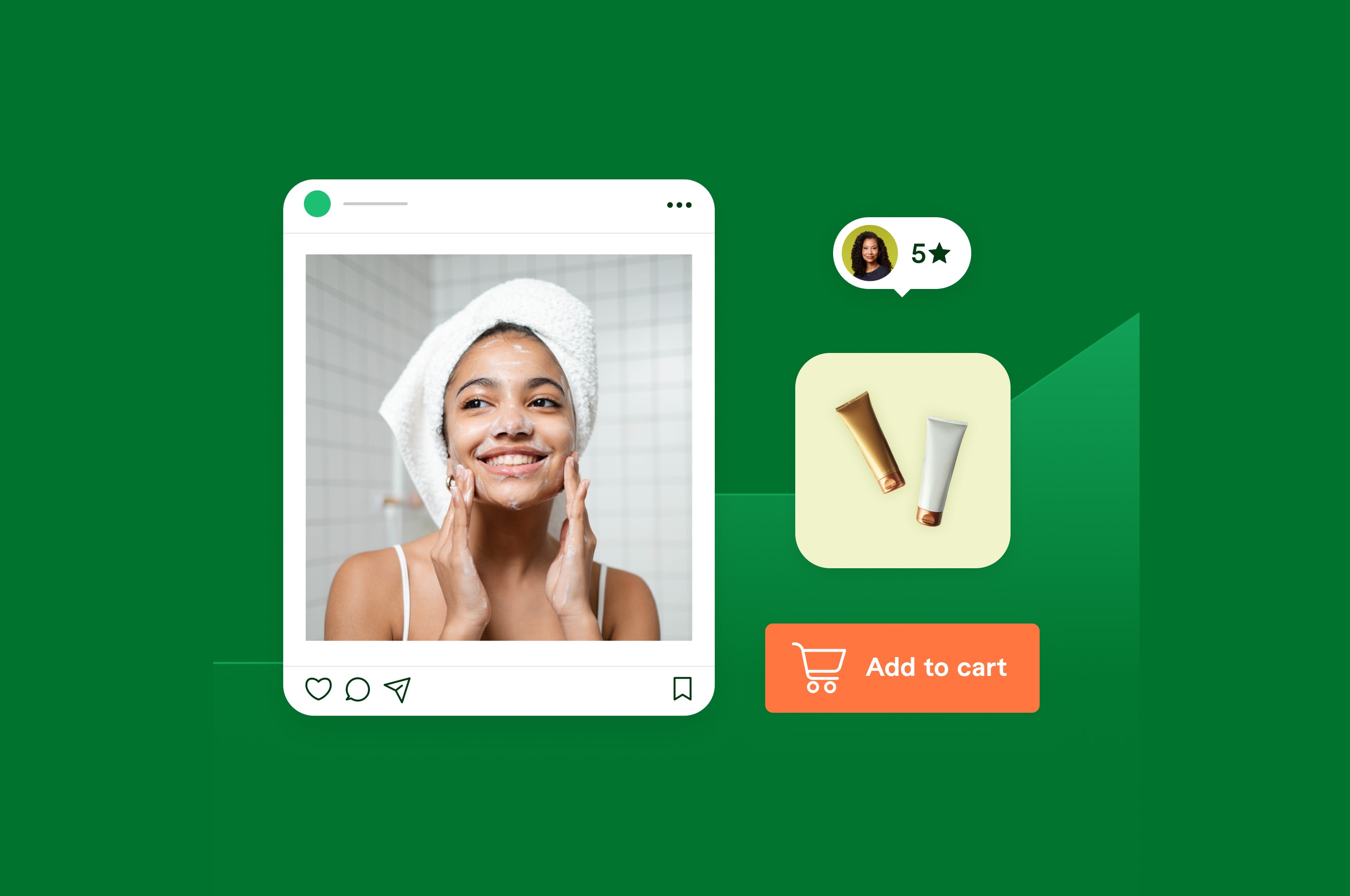
User-generated content (UGC) is a marketing strategy that focuses on sharing content your customers have created. This type of content helps potential customers see that others are already using and enjoying your product or service, increasing the chances that they themselves sign up or make a purchase from you.
However, many brands struggle with finding quality UGC to share with their audience. To help, we’ve put together 11 UGC strategies with examples of them in action, including UGC videos.
Read below to discover tactics and tips for gathering user-generated content and incorporating it into your marketing strategy.
Find a UGC Creator for Hire
11 UGC strategies to try
Take advantage of these 11 killer UGC strategies to help your brand gather user-generated content and use it to engage your audience and make sales.
1. Create a branded hashtag
The first strategy is to create a branded hashtag that you want customers to use when sharing UGC. This gives your business a simple way to aggregate and search for content your customers share.
Chelse Hensley, social media strategist at graphic design software Visme, states, “There's a reason hashtags have been the GOAT for all these years! It's a simple, effective way to organize UGC content from users. Making sure you cement the call-to-action for users to tag your business using a distinct hashtag will make finding content so much easier.”
Here’s an example of how Pottery Barn does this on its Instagram page:

Pottery Barn’s Instagram
The brand includes clear guidelines in the caption on what to do if users want to be featured: share their photos with the hashtag #mypotterybarn.
Anyone can click on the hashtag to see all the posts with this hashtag. Interested users can even follow the hashtag to see featured posts in their feeds.

#mypotterybarn hashtag on Instagram
Also, when you follow your company’s branded hashtag regularly, you’ll never miss out on a single user-generated post. You’ll gather plenty of UGC to feature when creating your social media content calendar.
2. Encourage UGC with contests and giveaways
Detergent brand Tru Earth uses contests to help gather UGC. Co-founder Ryan McKenzie says, “Tru Earth often runs contests, inviting customers to share their creative use of our products or tips for living a more sustainable lifestyle. Not only do these contests generate buzz and attract new audiences, but they also inspire other customers to adopt eco-friendly habits.”
One brand that nails gathering UGC via contests is GoPro. It has a page on its website just for users to submit their photos (taken with a GoPro, of course) for a chance to win a prize.
GoPro then features its contest winners across its social media platforms. Not only does this provide the brand with endless UGC, but it also creates an opportunity for GoPro to promote its campaign.
Take a look at this Instagram post featuring a recent winner—a breathtaking photo that highlights GoPro's exceptional photography. The caption invites followers to join in the action by submitting their own shots for a chance to win a cash prize!
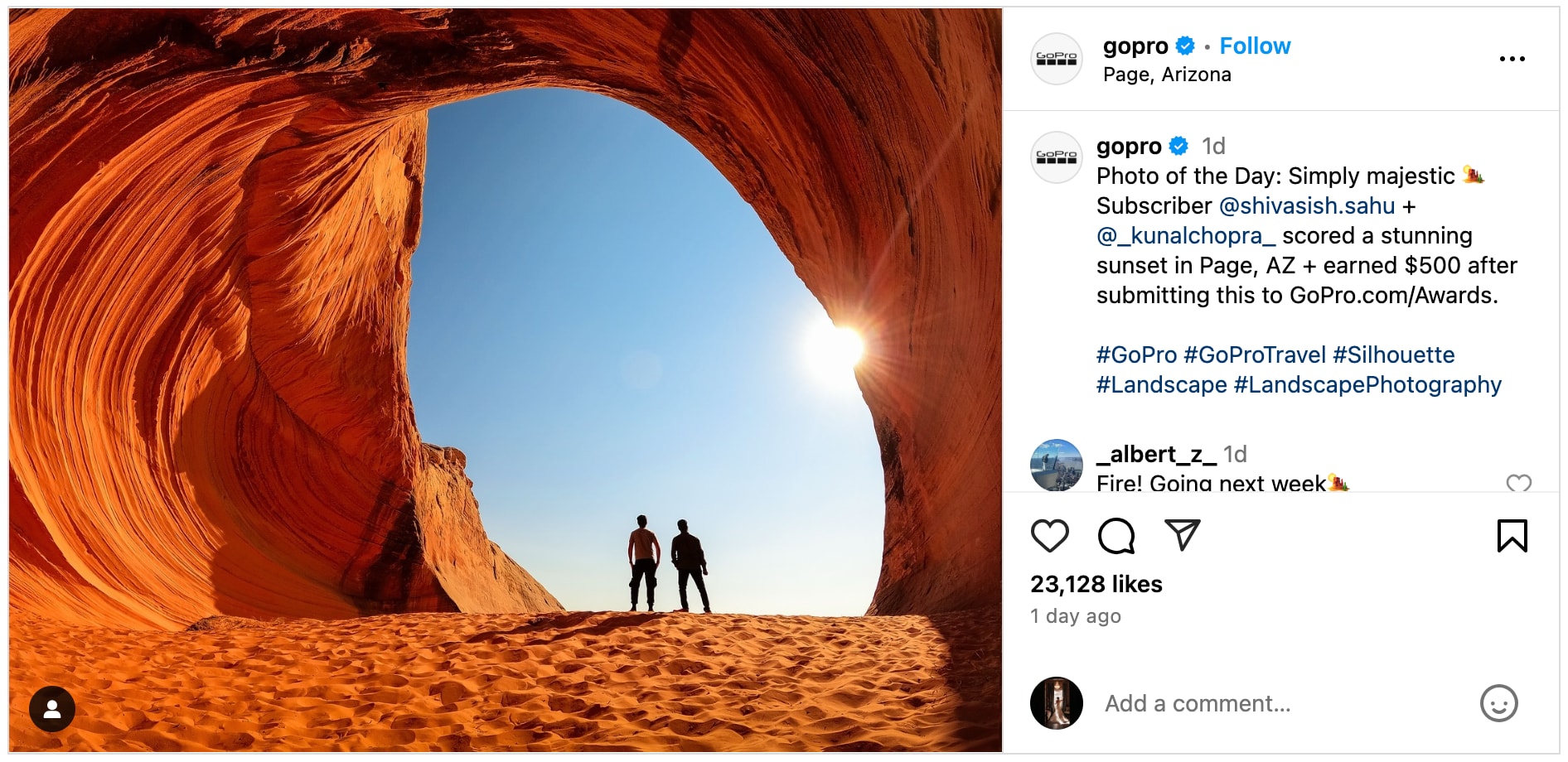
GoPro’s Instagram
This is an excellent way for the brand to reward its customers and generate an endless supply of incredible photos and videos to share on its social media channels.
3. Feature customer reviews
Customer reviews, testimonials, and case studies are some of the best forms of UGC. These showcase specific customer experiences, helping other prospects feel more comfortable buying from you.
They’re also a great form of social proof, which is a psychological phenomenon where people tend to follow the actions of others. When prospects see that other people have had a great experience with your brand, they’re more likely to invest in it.
Product reviews and testimonials are easier for your customers to provide, and case studies require additional time and work from the customer and your team. Your customer has to sit for an interview, and someone on your content marketing team has to write the case study before it’s ready to share.
McKenzie with Tru Earth says, “We use positive UGC generated by our customers as testimonials on our website and marketing materials. This serves as a powerful tool for both engagement and conversion, as potential customers can easily relate to the experiences of their peers.”
We can see examples of this right on Tru Earth’s website:
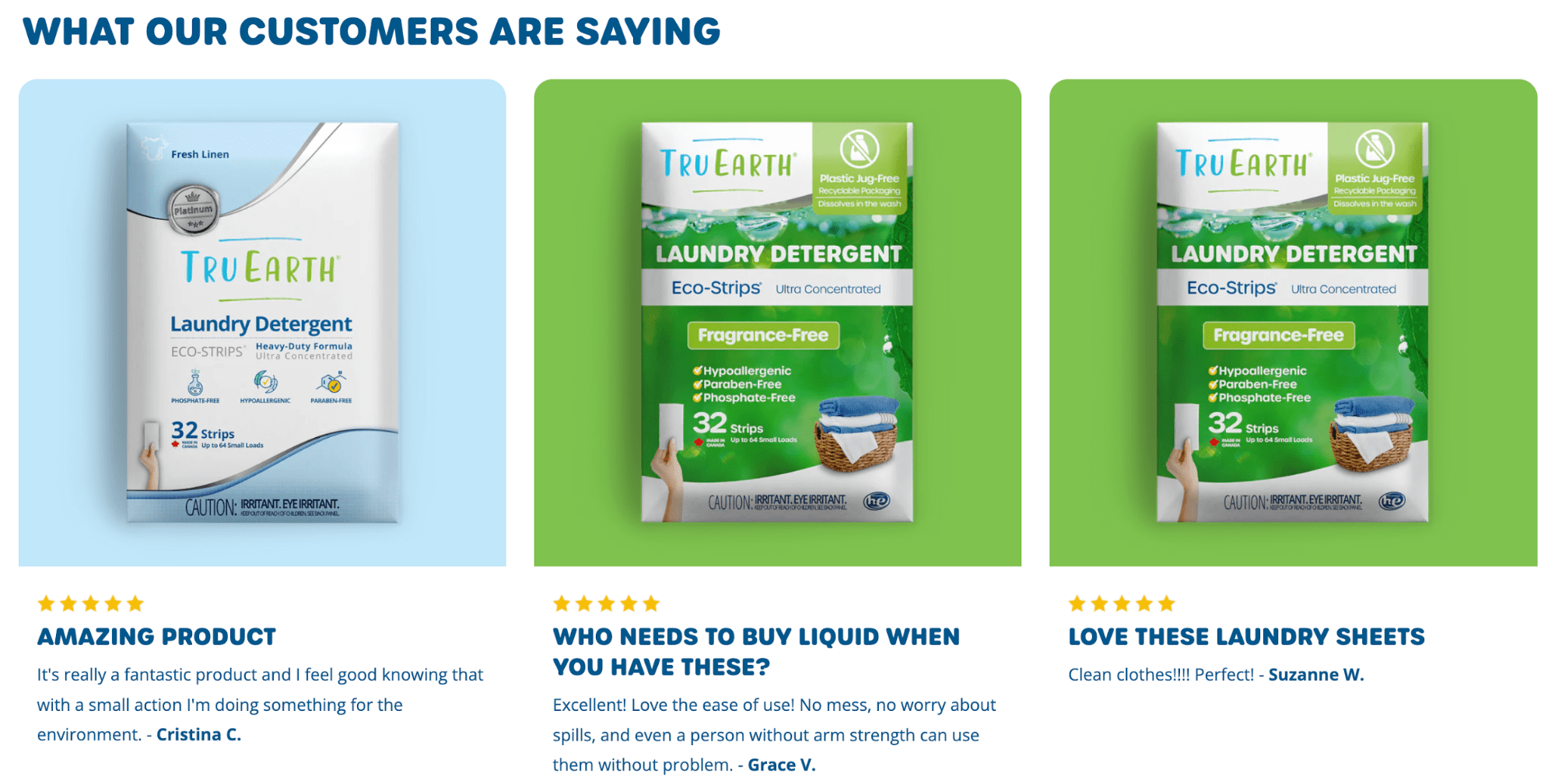
Tru Earth testimonials
Case studies focus on how a business’s product or service has helped a client or customer solve. Below is an example of some of the case studies and customer stories that Fiverr has shared of its users seeing success.

4. Create UGC ads
While organic UGC can help with your social media marketing strategy, UGC content also works well as paid ads. Why? UGC feels more authentic and is more likely to grab attention than other types of ads.
Ben McInerney, founder of Home Garden Guides, takes advantage of this approach “We use UGC in our retargeting ads on Facebook and Twitter to keep our brand top of mind whenever a potential customer is looking for the services that we offer. Our social media analytics indicate that more than 60% of our customers find us through these platforms, and the posts and ads with the highest engagement and that deliver the most conversions are those that feature UGC,” says McInerney.
Marketers commonly use this tactic on TikTok to help video ads blend into the feed more seamlessly.
Here’s an example of a UGC ad a pet creator made, sharing their experience with PetSmart groomers. PetSmart then promoted the video to provide a more authentic experience for the viewer.
This PetSmart UGC video uses one of the trademark TikTok voiceover voices and storytelling cadence, helping it fit in well with organic content. This way, users don’t feel like they’re watching a TikTok ad.
5. Collaborate with micro-influencers
Influencer marketing can also be a huge part of your user-generated content strategy. While you work to generate UGC organically, partnering with micro-influencers and UGC creators can help your brand gather high-quality, authentic content more quickly.
Micro-influencers are social media users with less than 100,000 followers. They have highly engaged, niche audiences and are more affordable to work with than more prominent influencers. A UGC creator is a social media content creator who creates UGC-like videos for brands.
Here’s an example of what this could look like from the online therapy company BetterHelp. The brand connected with famous TikTok influencer Dustin Poynter (“Red Flag Guy”) to share mental health green flags in the same style he does his other videos:
Common formats of influencer-made UGC include:
Product photos
You can search for influencers on social media, use a UGC platform to find creators, or check out a freelance marketplace like Fiverr as a part of your marketing efforts. Find someone who matches your target demographic and can create fantastic content that both of you can share on social media.
6. Create TikTok challenges
Dig into your creative side to see if you can create your own TikTok trend or challenge. Then, encourage other creators or brands to join in. You might want to partner with micro-influencers to build up momentum, but eventually, other creators might join in and give you even more UGC.
Graphic design tool Canva creates a number of design challenges on its TikTok channel using the hashtag #CanvaDesignChallenge. Here’s an example of one:
Users can then jump on the hashtag or try out the design challenge for themselves, creating a video that Canva can reshare with its audience.
Start browsing through TikTok to see if you can gather inspiration for a social media trend or challenge that could work well for your brand.
7. Offer incentives for UGC
If you haven’t captured much UGC in the past, consider offering an incentive. Incentivizing your UGC marketing campaigns can pique your audience’s interest and make them more likely to share their content with you.
Sometimes all you need to do is adjust your wording. Furniture retailer Crate and Barrel has a simple “Tag us to be featured” line in its Instagram bio:
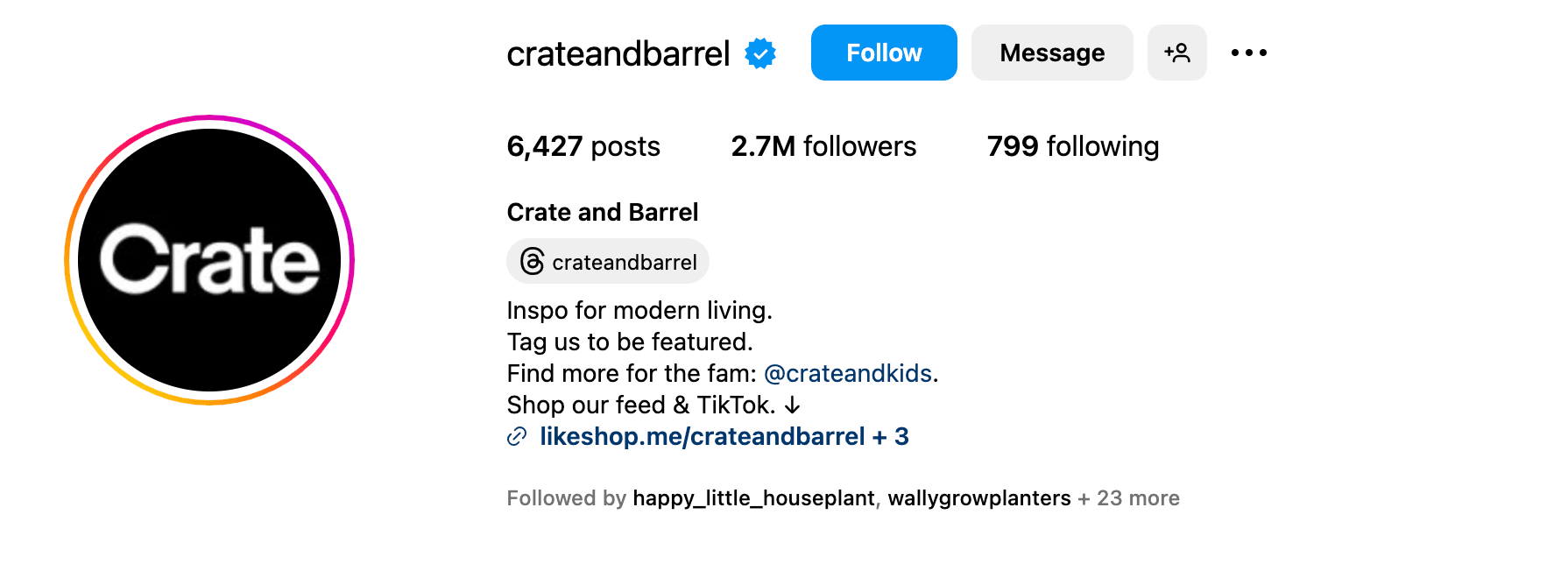
Crate and Barrel’s Instagram
For many social media users—especially if they’re looking to grow their following—that’s enough of an incentive.
But to truly stand out, you may need a strategy with even more significant impact. Think back to the example from GoPro. The camera brand incentivizes its user-generated content campaigns by offering $500 cash prizes to certain submissions. This increases the number of people who send in photos, hoping to win a prize.
Incentives you could use include:
Cash prizes
Discounts
Free products
Gift cards
8. Showcase UGC on your social profiles and website
The core part of UGC is being able to share the photos and videos your customers create on your brand’s own channels. Let’s dive into examples of user-generated content so you’ll know how to share it on your own pages.
First, take a look at this photo from Brilliant Earth on Instagram.
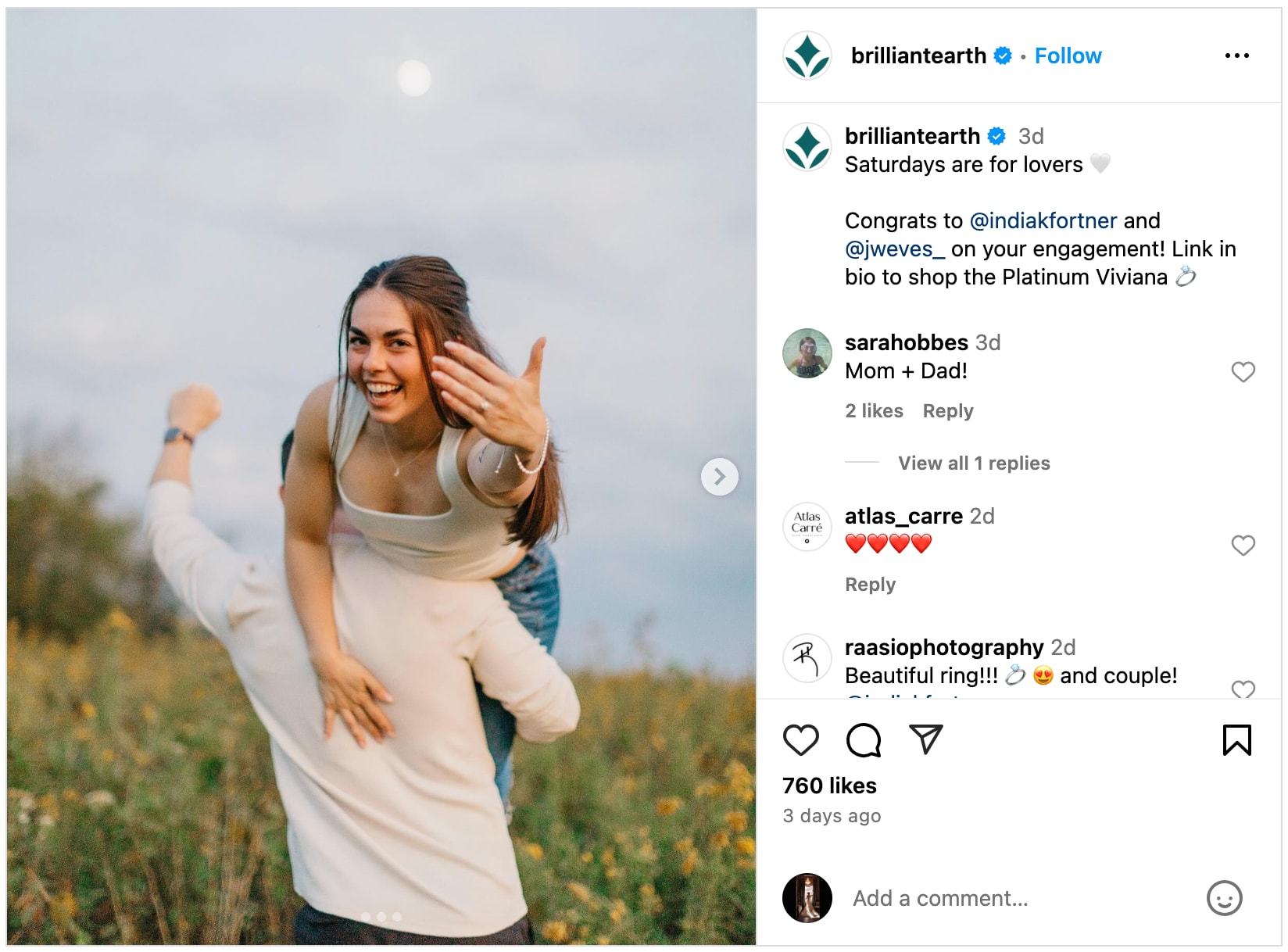
Brilliant Earth’s Instagram
Brilliant Earth followed two essential rules regarding UGC: the brand tagged the creator and got permission before sharing the post on its Instagram account.
If you follow the tag to the original creator’s page, you’ll see Brilliant Earth left a comment asking for explicit permission to share the photos.
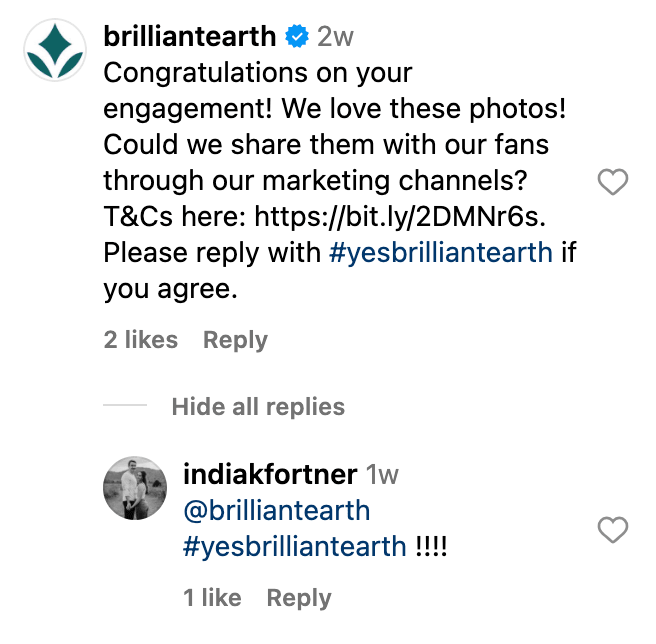
Brilliant Earth’s Instagram
This step is extremely important. 95% of creators agree that brands should reach out for permission before resharing, so put together a plan for this.
Some options include:
Send a direct message to the user
Leave a comment on the post
Ask them to reply with a hashtag
Create a form you can share to get permission
9. Create shoppable UGC posts
If you find customer content featuring your products, consider turning them into shoppable social media posts. One study found that users interacting with some form of UGC convert at a 102.4% higher conversion rate than the average.
With that in mind, ecommerce brands should incorporate UGC into their social commerce strategy. Curate product photos from real customers, tagging the product from your social media catalog.
Here’s an example from Anthropologie. The clothing brand showcased a customer’s photo, thoughtfully tagging each featured product to make it effortless for viewers to shop their favorite looks.
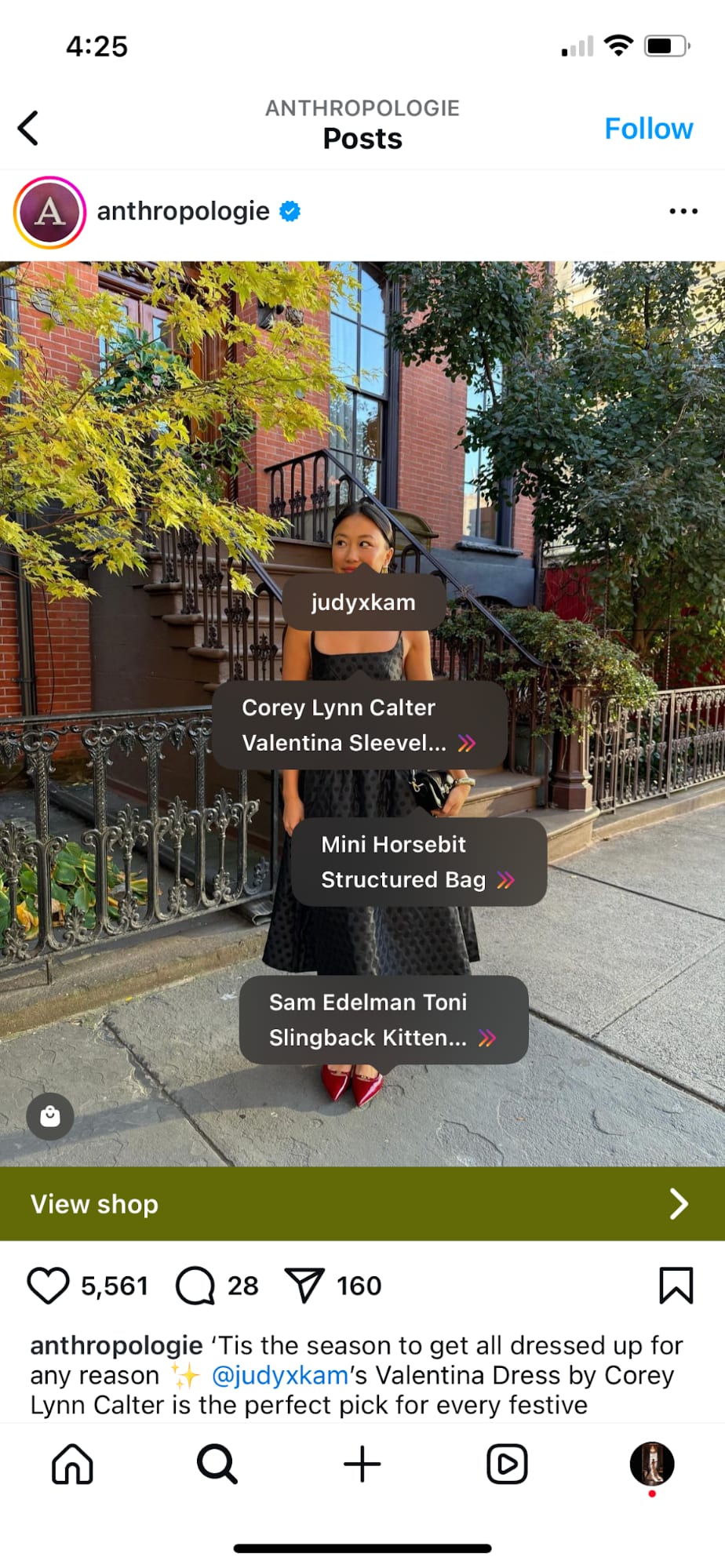
Anthropologie’s Instagram
10. Share social media mentions
Highlight the buzz around your brand by showcasing real conversations from your audience. A popular way to do this is by screenshotting tweets that mention your brand and sharing them on Instagram.
You can use screenshots from X/Twitter, Facebook, review sites, blogs, and social media comments. Showcase happy customers giving your brand accolades or share funny posts your customers have made about your brand.
You can also share posts that relate to your industry to gather even more UGC and content ideas. Here’s an example from baby brand Newton of what this could look like:

Newton’s Instagram
This is a great way to share customer content in your Instagram posts without curating a fully self-promotional feed.
11. Market your product as a lifestyle
This one takes a bit more effort and may not be the right strategy for each brand, but posing your product as more of a lifestyle can be a great way to entice customers to share photos of your products.
Stanley is a great example of this. The water bottle brand has become a staple for certain influencers, creating a lifestyle around the brand that many content creators love to share on their social media feeds.
Take a look at this example from Stanley’s Instagram. The brand rounded up a handful of photos of their customers incorporating Stanley water cups into their Halloween costumes.
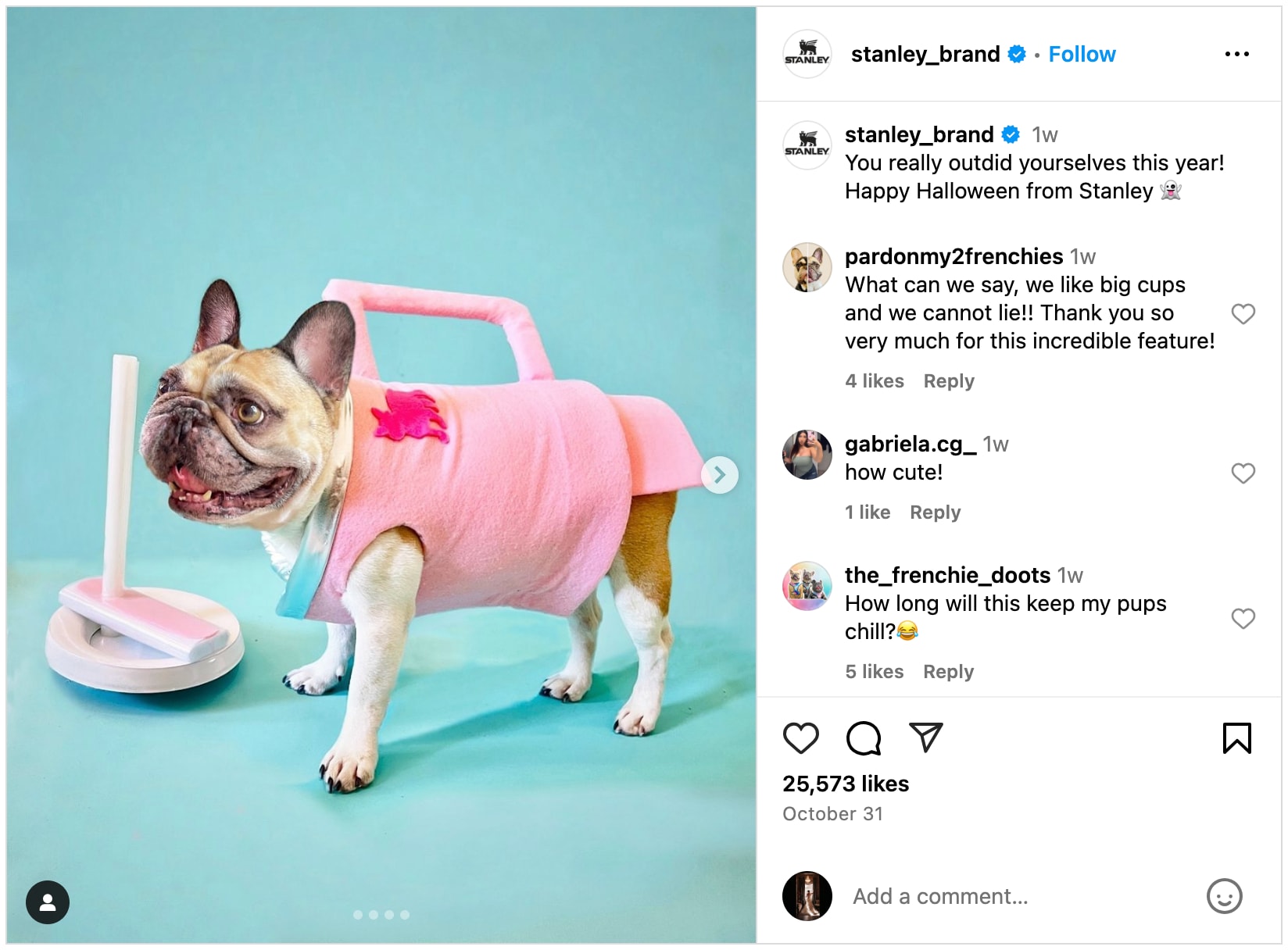
Stanley’s Instagram
Not all brands can get away with this. By marketing its product as a lifestyle rather than just a water bottle, Stanley has sparked a trend where customers eagerly purchase new items and share them on social media—providing the brand with a steady flow of UGC opportunities.
UGC strategies by platform
Some UGC marketing strategies work better on specific platforms. Look at how you can gather and share UGC on each major social network.
Instagram is an excellent platform for collecting UGC due to its visual nature. Keep these tactics in mind when gathering and sharing user-generated images and videos:
Instagram Stories: When you’re tagged in Stories, Instagram gives you the option to reshare them to your own Story. This is an easy way to share UGC without formalities since Instagram users generally expect tagged Stories to be reshared.
Instagram Reels: These short-form videos are a great format for UGC. Work with creators to get Reels made, or see if you can find some featuring your product on the platform.
Hashtag Campaigns: Because you can search for a hashtag’s feed on Instagram, this is the perfect place to feature your branded hashtag.
Cross-Platform UGC: Share screenshots of customer reviews, comments, tweets, and more as another form of UGC on Instagram.
TikTok
Use these tactics for finding and sharing UGC on TikTok:
TikTok Challenges: Create a challenge and ask your audience to join in. Offer an incentive for participants to increase challenge videos and spread the word.
Duets and Stitches: Two features on TikTok, dueting and stitching, allow you or your followers to combine a video with an existing video on the platform. Consider dueting or stitching relevant videos from your audience, or ask your audience to duet or stitch your videos.
UGC Ads: TikTok reigns supreme when it comes to UGC ads. Collaborate with creators to generate video ads that feel authentic to the TikTok feed.
YouTube
YouTube is an outstanding platform for long-form UGC. There are a few different ways to incorporate UGC into your YouTube video strategy, including:
Long-Form Video Testimonials: Get long-form videos of your customers trying out and reviewing your products. While effective, remember that content like this will likely cost more than short-form videos.
Unboxing Videos: Influencers often showcase brand-sent products in unboxing videos, opening packages on camera to share with their audience.
YouTube Shorts: YouTube Shorts are short-form videos, just like Instagram Reels and TikToks. You can follow a UGC strategy similar to that on other platforms.
Take advantage of these use cases for gathering user-generated content via Facebook:
Facebook Groups: Many brands create a brand-centric Facebook Group to build a community for its users. This can be a great way to offer value to your customers while gathering UGC from their posts.
Facebook Live: Go Live on Facebook to connect with your audience in real time and get their feedback and comments on your products.
Polls and Quizzes: Facebook offers a polling post type so that you can ask your audience questions directly and get their responses. These polls are another great type of UGC.
And finally, use these tactics for LinkedIn UGC:
Professional Story-Sharing: LinkedIn is ideal for long-form posts and is an outstanding platform for customers to share their stories about your brand.
LinkedIn Articles: LinkedIn also has a built-in article-sharing platform where you can collaborate with creators to get mentions for their content.
Polls: Similar to Facebook, poll your followers to gather feedback and opinions you can reshare.
Employee-Generated Content: Another important type of UGC is content gathered from your employees about their experiences working for your brand.
UGC tips
To ensure a successful UGC marketing strategy, keep these four key tips in mind.
Don’t use organic UGC without permission
Remember, 95% (the overwhelming majority) of creators believe brands should ask for permission before resharing their content.
On the other hand, nearly half of marketers say there isn’t much risk in using creator content without permission. There’s a significant difference in opinion here, and brands need to take this into consideration.
Think about it like this. While it can be exciting for a creator to be featured on a big brand’s social platforms, it’s also alarming to suddenly see their photo or video on another profile or brand page without their knowledge.
Along with asking for permission, brands must credit the original creator. The survey cited earlier discovered that nearly 40% of creators didn’t receive credit when a brand reposted their UGC.
Use consistent incentives
We discussed how incentivizing your UGC campaign can help you gather more content from real people. However, you don’t want to throw out a new incentive each time you run a new campaign.
Instead, select one option and stick with it.
Think back to GoPro and its UGC program. The brand has created a landing page for customers to submit their real-life photos and video footage captured with a GoPro device. Then, the brand says selected footage can get rewarded and that “social media features, GoPro gear, and cash awards are up for grabs.”

GoPro
GoPro has figured out its incentive program and stuck with it. Do the same.
Build a group of creators to work with regularly
Building a community of creators or influencers you regularly work with helps you build brand awareness and recognition. You can build trust through these relationships and assemble a group of creators who always provide you with high-quality UGC.
Start by experimenting with various photo and video content styles from different creators. Identify those whose work resonates with your target audience and drives higher customer engagement.
Use a UGC platform to centralize everything
Take advantage of UGC platforms to help make finding and sharing user-generated content easier than ever.
For example, you can search through Fiverr’s marketplace of content creators. You’ll find creators who align with your brand values and offer high-quality content creation services. Keep all communication and content within a single dashboard to easily find and grab images and videos to share with your audience.
Buy and sell UGC services on Fiverr
Whether you’re a business looking to gather more UGC or a creator wanting to offer your content creation services, Fiverr is the perfect spot. Brands can easily search for the right creators for their needs, while content creators can find companies to work with.
Create a buyer or seller profile today to get started.
UGC strategies FAQs
1. What is a UGC strategy?
A UGC strategy is a marketing strategy focused on gathering and sharing user-generated content. The hardest part of a successful UGC strategy is finding enough UGC to be able to share it as a part of your overall brand content strategy.
2. Is UGC worth it?
UGC can help you improve brand loyalty, trust, and sales. When consumers interact with UGC, brands see a conversion lift of 102.4%, proving that this type of content impacts purchasing decisions.
3. What are some UGC niches?
UGC can be used across a number of industries and niches, like:
4. How can I increase my UGC?
To increase your UGC content intake, use the strategies we’ve covered here in a UGC campaign. Creating a branded hashtag, offering an incentive, or running a contest/giveaway can be great ways to gather UGC.
